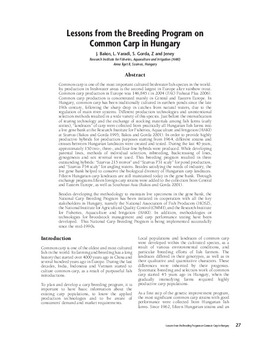Lessons from the breeding program on common carp in Hungary

Citation
Bakos, J. et al. (2006). Lessons from the breeding program on common carp in Hungary. p. 27-33. In: Ponzoni, R.W. ; Acosta, B.O. ; Ponniah, A.G. (eds.) Development of aquatic animal genetic improvement and dissemination programs: current status and action plans. WorldFish Center Conference Proceedings 73. Penang, Malaysia. 120 p.
Common carp is one of the most important cultured freshwater fish species in the world. Its production in freshwater areas is the second largest in Europe after rainbow trout. Common carp production in Europe was 146,845 t in 2004 (FAO Fishstat Plus 2006). Common carp production is concentrated mainly in Central and Eastern Europe. In Hungary, common carp has been traditionally cultured in earthen ponds since the late 19th century, following the sharp drop in catches from natural waters, due to the regulation of main river systems. Different production technologies and unintentional selection methods resulted in a wide variety of this species. Just before the intensification of rearing technology and the exchange of stocking materials among fish farms (early sixties), “landraces” of carp were collected from practically all Hungarian fish farms into a live gene bank at the Research Institute for Fisheries, Aquaculture and Irrigation (HAKI) at Szarvas (Bakos and Gorda 1995; Bakos and Gorda 2001). In order to provide highly productive hybrids for production purposes starting from 1964, different strains and crosses between Hungarian landraces were created and tested. During the last 40 years, approximately 150 two-, three-, and four-line hybrids were produced. While developing parental lines, methods of individual selection, inbreeding, backcrossing of lines, gynogenesis and sex reversal were used. This breeding program resulted in three outstanding hybrids: “Szarvas 215 mirror” and “Szarvas P31 scaly” for pond production, and “Szarvas P34 scaly” for angling waters. Besides satisfying the needs of industry, the live gene bank helped to conserve the biological diversity of Hungarian carp landraces. Fifteen Hungarian carp landraces are still maintained today in the gene bank. Through exchange programs fifteen foreign carp strains were added to the collection from Central and Eastern Europe, as well as Southeast Asia (Bakos and Gorda 2001). Besides developing the methodology to maintain live specimens in the gene bank, the National Carp Breeding Program has been initiated in cooperation with all the key stakeholders in Hungary, namely the National Association of Fish Producers (HOSZ), the National Institute for Agricultural Quality Control (OMMI), and the Research Institute for Fisheries, Aquaculture and Irrigation (HAKI). In addition, methodologies or technologies for broodstock management and carp performance testing have been developed. This National Carp Breeding Program is being implemented successfully since the mid-1990s.
Permalink
Date Available
Type
Publisher
Copyright
CC BY 4.0
Research Themes
Topics
Language